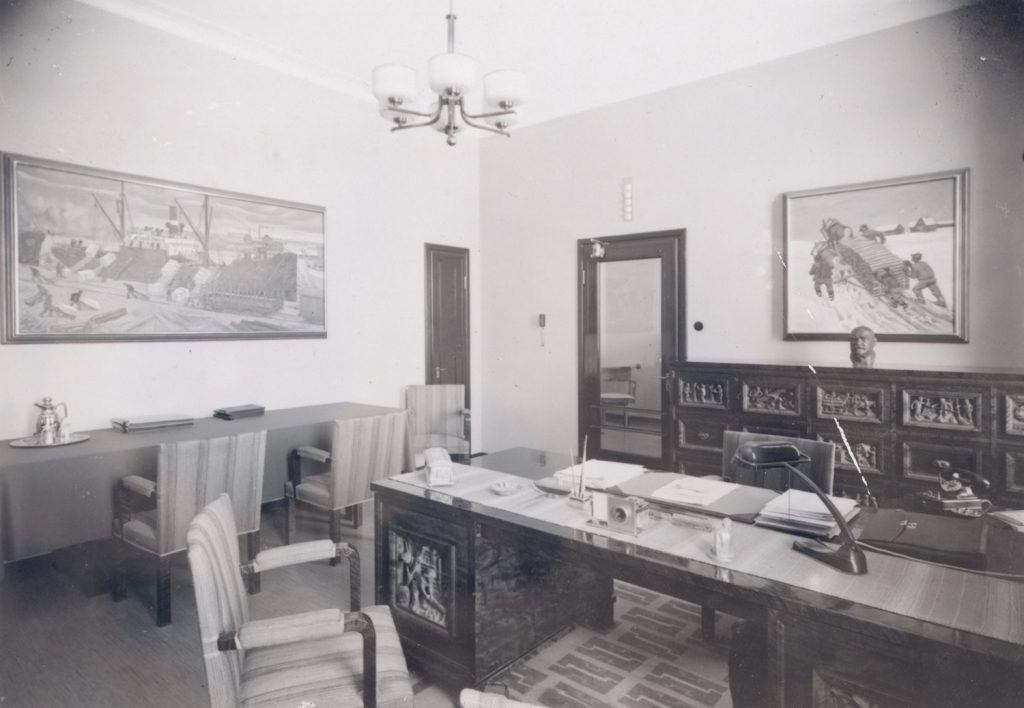A photograph from the office of the managing director for Serlachius Company
August
Designed by Bertel and Valter Jung, the head office of the G. A. Serlachius Ltd in Mänttä was completed in 1934. In the photograph taken by photographer Henrik Seppänen in 1938, the office of managing director Gösta Serlachius presents itself in its original decor. The first-floor furnishings and interior decoration of all representational spaces in the building had been meticulously designed.
Already from the outset it was planned that the head office would house art, creators of which were chosen from among Gösta Serlachius’ trusted artists. Marcus Collin (1882–1966) who participated in designing the overall decoration plan, got to create for the managing director’s office three paintings which were envisaged to depict lumbering. Gösta Serlachius himself was especially pleased with the artwork visible on the right-hand side. In the correspondence, the depiction of a load pulled in a heavy slush was referred to as “a load of pulp wood and auxiliary horse”. Located opposite the work, and remaining outside the picture, another painting had tree felling as subject. The third, the largest work in the room, was supposed to depict a storage of logs on ice. Serlachius was, however, not very keen on the theme. It resembled too much the other works in the room that are connected with timber harvesting, and, on the other hand, stock wood – that is sawn timber – did not belong to the pivotal raw materials of a company that had profiled itself in pulp, paper and paperboard. Among others, planting saplings was proposed as a new theme, but the large-scale painting required something visually more complex. Artist Collin ended up in the other extremity of the manufacturing process: the two-meter-wide painting is filled with a harbour view that reminds one very much of Jätkäsaari in Helsinki. In it, the pulp bales of G. A. Serlachius Ltd are being taken on board a ship. The theme connects Mänttä with international trade and refers to the Mänttä pulp mill which was established during Gösta Serlachius´ time.
A part of the Serlachius combine, Kolho carpentry workshop created the custom-made furniture for the room. The pieces of furniture were designed by Birger Hahl, who in visual and practical matters received explicit instructions from Gösta Serlachius. Serlachius commissioned of sculptor Hannes Autere their sculpted ornamentations, which depicted the whole combine’s wide field of operations in agriculture, forestry, water management and wood industries. On the desk, different motifs including hunting, fishing, mill trip, cultivation of new land, silviculture and hand sawing have a connection to Gösta Serlachius’ personal operations as farm owner. On the chest of drawers discernible in the backdrop there are seven image surfaces depicting forestry work and manufacture of wood pulp. Additionally, eight simpler drawers have been decorated with animal-themed handles.
Five reliefs on the cabinet that remained behind the camera depict manufacture of rag pulp and rag paper, in other words, the old method which at first was adopted in Mänttä. The furniture made from flame birch and stained greenish grey also included a long meeting table, a round side table, on which there is a telephone in the picture, as well as seven upholstered chairs.
Helsinki-based art smithy Viri created the silver writing instruments visible on the desk. Although Gösta Serlachius’ secretary typed most of his letters, he wrote a lot by hand. When ordering his writing instruments Serlachius reminded that he preferred a large enough ink container. A German-style desk lamp, the plainest object of the decor, was classic already in the 1930s. The light fixture on the ceiling, along with all fixed lamps at the head office, belong to the series manufactured by Taito Ltd. The row of bulbs above the door forms a part of the modern optical paging system utilised in the head office.
There are four photo albums on the conference table beside the silver water jug and the glasses. Gösta Serlachius himself also took pictures, but photographs documenting company buildings and operations were commissioned of professional photographers. First-class, presentable photographs were important for company’s public image, and beside the neat presentation albums they were preserved together with pertaining information in the picture archive, as well. Nowadays, company’s picture archive forms a part of the Serlachius Museums’ photograph collection.
Milla Sinivuori-Hakanen
Senior Curator
Archives of Gösta Serlachius and G. A. Serlachius Ltd have been used as the source of the text. You may learn more of the history of the head office in museum’s video stories.
The managing director’s as well as the board’s office have been preserved furnished with their original furniture and are on show for visitors at Serlachius Headquarters.


